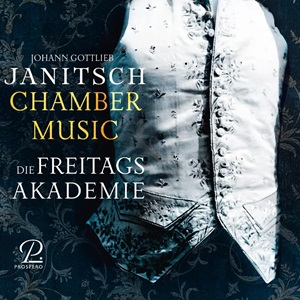
Johann Gottlieb Janitsch (1708-1763)
Chamber Music
Sonata da camera for transverse flute, oboe, violin and bc in D major ‘Echo’
Sonata da camera for transverse flute, oboe, viola and bc in C minor, Op 1 No 1
Sonata for transverse flute, violin, viola and bc in G major, Op 1 No 2
Sonata da camera for oboe, two violas and bc in E minor
Quadro for oboe, violin, viola and bc in G minor ‘O Haupt voll Blut und Wunden’
bc=basso continuo
Die Freitagsakademie
rec. 2022, SRF2 Kultur, Zurich, Switzerland
Reviewed as a stereo 16/44 download with PDF booklet from Proper Music
Prospero PROSP0069 [66]
The court chapel of Frederik the Great, King of Prussia, was one of the most important musical institutions of Germany in the mid-18th century. In his service were some of the most prominent musicians of the time, such as the Benda brothers, the Graun brothers, the keyboard player Carl Philipp Emanuel Bach and the flautist Johann Joachim Quantz. This disc includes music by a lesser-known member of Frederick’s chapel, Johann Gottlieb Janitsch.
He was born in Schweidnitz in Silesia (now Świdnica in Poland) and was educated in the bass viol. After having been a law student in Frankfurt an der Oder, where he also played a major role in local musical life, he joined the chapel of Frederick, then still Crown Prince of Prussia, in Ruppin, later Rheinsberg. There, he started a series of weekly concerts on Fridays, the Freitagsakademie. It is likely that his chamber music was written for performances during these concerts, in which both professional and amateur players participated. When Frederick became King of Prussia and moved his court to Berlin, Janitsch continued his Friday academies there.
He was especially famous for his quartets; his colleague Johann Wilhelm Hertel considered them “the best specimens of the genre”. They were models of contrapuntal technique; this form also frequently appears in the œuvre of Telemann and Fasch. As one can see in the track-list, they come with different titles: quadro, sonata or sonata da camera. Like Telemann, Janitsch seems to have had a liking for unusual combinations of instruments. An example is the Sonata da camera in E minor for oboe d’amore, two violas and basso continuo. This combination of instruments results in a dark sound. This is connected with the key of E minor, which Johann Mattheson characterised as “pensive, profound, sad, expressive of grief”.
Talking of grief, the Sonata in G minor takes a special place in Janitsch’s œuvre. Whereas his quartets usually have three movements, in the order slow – fast – fast, which was the convention in Berlin in the mid-18th century, this quartet has four movements in the order known from Corellian sonatas. The scoring is for oboe, violin, viola and basso continuo. The violin part is rather low; in another recording it was also played on the viola. This reflects the nature of this work, in which Janitsch refers to the death of his daughter. In the second slow movement – adagio ma non troppo – the oboe plays the chorale O Haupt voll Blut und Wunden.
The combination of instruments was already mentioned. For us, these combinations, except the one with two viola parts, may be not uncommon, but in Janitsch’s time it was different. Especially notable is the role of the viola. In the baroque period, this instrument had an almost exclusively harmonic function. Concertos and sonatas for viola were very rare, and in Telemann’s quartets the third part is mostly for a viola da gamba. In the mid-18th century, composers in Berlin still wrote pieces and parts for viola da gamba, mostly inspired by the presence of the virtuoso Ludwig Christian Hesse at Frederick the Great’s court. But in music for general use they preferred the viola, which became increasingly fashionable. Sometimes parts for viola and viola da gamba were interchangeable.
It has taken some time, but in recent years the music world seems to have discovered Janitsch, as several discs with his music have been released. There are also a couple of discs with his music on the market, recorded by an ensemble with the name Friday Academy Berlin. They should not be confused; this ensemble is from Switzerland. It includes some of the finest players on the early music scene. The transverse flute is played by Jörg Fiedler, and the oboe and oboe d’amore by Katharina Suske, who is also the ensemble’s director. Ilia Korol plays the violin, and Wolfram Fortin the viola. In the basso continuo, we hear Jan Krigovsky on the violone and Sebastian Wienand on the harpsichord. Together they deliver energetic and engaging performances of these five splendid quartets, which give a good idea of the nature and quality of his work. Janitsch was much respected by his contemporaries; listening to this disc makes that easy to understand.
Johan van Veen
Buying this recording via a link below generates revenue for MWI and helps us keep free access to the site



















